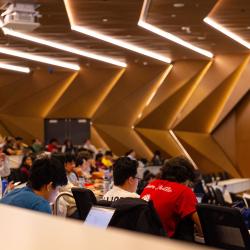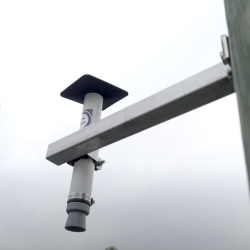Coal Dust Clouds a Baltimore Neighborhood’s Fight for Clean Air
University of Maryland and Johns Hopkins Bloomberg School of Public Health researchers link air pollution in Baltimore’s Curtis Bay community to nearby coal terminal activity and wind.

Baltimore’s Curtis Bay community has historically been exposed to various forms of air pollution. Surrounded by heavy industrial activity and diesel vehicle traffic, residents have complained about air quality for decades despite current mitigation efforts.
Now, a new study by researchers from the University of Maryland, Johns Hopkins Bloomberg School of Public Health and the South Baltimore community establishes a link between air pollution in Curtis Bay to an adjacent open-air coal facility at the Port of Baltimore. Published in the journal Air Quality, Atmosphere & Health, the study revealed that levels of air pollutants (including particulate matter and black carbon) were highest when there was both bulldozer activity and wind blowing from the nearby CSX Corporation’s Curtis Bay Piers terminal. Exposure to coal dust has been linked to adverse impacts to both environment and human health.
“To prove the role of coal dust, we had to answer rigorous questions—Curtis Bay is a residential neighborhood in the middle of a traditionally industrial area,” explained air quality expert and study co-author Russell Dickerson, a professor of atmospheric and oceanic science at UMD. “When is there dust? Where did it come from? What direction does the wind blow? How big are the pollutant particles? How long do they last in the atmosphere and how far can they travel? To prove that the dust was coming from the coal terminal, we had to carefully track wind direction and bulldozer movement across the area.”
Originally built in 1882, CSX Corporation’s Curtis Bay Piers terminal is a large storage facility for coal brought by rail primarily from coal mines in the mid-Atlantic region to transport abroad. For more than a century, the facility significantly contributed to Baltimore’s economic activity and status as a top exporter of American coal. In 2021, an explosion at the terminal showered the neighborhood with coal dust and led to increased complaints as well as additional scrutiny from federal, state and local entities.
As a follow-up to their 2021 findings, the team’s new paper further examined the terminal’s bulldozer activity and its potential air pollution impacts. The researchers set up meteorological and air pollution-monitoring devices around the Curtis Bay neighborhood, as well as a camera programmed to take pictures at regular time intervals to observe visible bulldozer activity at the coal terminal. From July 2022 to July 2023, the researchers gathered minute-by-minute data on wind direction, visible presence of bulldozer activity on coal piles at the terminal and levels of particulate matter air pollutants of various sizes—including black carbon, a core component of soot and coal dust.

“We found that air pollutant levels tended to be significantly higher when the wind was blowing from the terminal compared to when it was blowing from other directions. The same thing happened when bulldozers were working on the coal piles at the terminal,” Dickerson explained. “We observed that pollutant levels were highest when both downwind and visible bulldozer activity occurred simultaneously. This is fairly consistent with what we found in our earlier study.”
The team’s findings also suggest that existing mitigation measures at the coal terminal are not sufficient.
“To keep the coal dust down, they hose the coal piles down with water and surfactant, which is similar to detergent. There are also wind fences they put up to try to hold the air pollutants back," Dickerson explained. “But these methods are insufficient and there’s still considerable air pollution in the neighborhood. The community is currently trying to work with CSX to reduce unwanted coal dust movement, including creating a full enclosure of the terminal so that dust can’t escape as easily.”
The team hopes to continue monitoring the coal terminal’s potential impacts on air pollution and collaborating with Curtis Bay residents for possible solutions. According to Dickerson, plans for improvements are underway with CSX’s agreement to replace its locomotives with electric ones after an earlier study documented diesel pollution in the area—a “small victory” in the ongoing fight for improved air quality in the South Baltimore community.
“This is an issue of environmental justice. Our findings show that this coal dust can travel between 1,000 to 2,000 meters, which restricts its impact to a particular area and makes this a relatively local issue,” Dickerson said. “There is a legacy of industry there in Curtis Bay and it’s our responsibility as Maryland scientists to come together with our different research capabilities and skills to solve a very real environmental problem affecting people here.”
###
The paper, "Relation of Wind Direction and Coal Terminal Activity Patterns with Air Pollution Burden in a Community Bordering a Coal Export Terminal, Curtis Bay, Maryland, USA," was co-authored by Lauren Deanes, Bonita Salmerón, Matthew Aubourg, Laura Schmidt, Kristoffer Spicera, Caila Wagara, Gregory Sawtell, Carlos Sanchez-Gonzalez, David Jones, Angela Shaneyfelt, David Hagan, David McClosky, Nicholas Spada, Russell Dickerson, Vivek Ravichandran, Sacoby Wilson, Anik Burman, Abhirup Datta and Christopher Heaney.
Support for the research was provided by the National Institute of Environmental Health Sciences, the Johns Hopkins Community Science and Innovation for Environmental Justice Initiative, the National Institute for Occupational Safety and Health, the UC Davis Environmental Health Science Center Core, the University of Maryland Grand Challenge grant, and the Maryland Department of the Environment.







